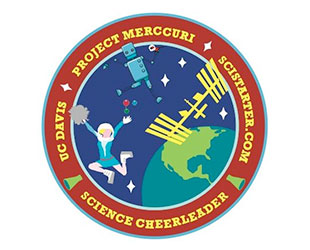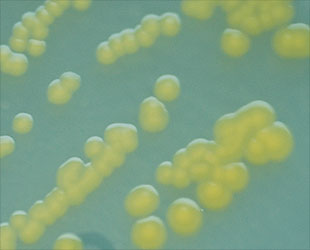March 11, 2014 — A very, very (very) small sample from John Glenn's 1962 Mercury capsule "Friendship 7" is set to launch to the International Space Station as part of an experiment organized by professional cheerleaders.
The microbial spacecraft sample — literally, the bacteria Pantoea eucrina — is among 48 microbes swabbed from a variety of historical places (like the Smithsonian's National Air and Space Museum) and sports stadiums that will be compared for the rate at which they grow in space.
The swabbing was led by Science Cheerleader, a group of current and former NFL and NBA cheerleaders pursuing careers in science and technology. The organization plays off public stereotypes to encourage participation in citizen science activities.
The Project MERCCURI (or Microbial Ecology Research Combining Citizen and University Researchers) payload is launching on SpaceX's third Dragon spacecraft to resupply the space station for NASA. The mission, which is dubbed Commercial Resupply Services-3 (CRS-3), is scheduled to lift off from Cape Canaveral Air Force Station in Florida on Sunday (March 16).
Update: The launch has been rescheduled for April 18.

Project MERCCURI mission patch. (Project MERCCURI) |
The project is a partnership between Science Cheerleader, SciStarter.com and the University of California, Davis (UC Davis). It is one of two science experiments flying aboard CRS-3 that were chosen by Space Florida's ISS Research Competition held in 2012.
Space playoff
Project MERCCURI aims to improve the understanding of how different microbes behave in microgravity to assist in the planning for long-duration space missions. It may also offer new insight into microbe growth in built environments on Earth.
But the choice of where the microbes were collected from points to another focus of Project MERCURRI.
"This initiative is not just about significant research," said Darlene Cavalier, the founder of Science Cheerleader and SciStarter, as well as former professional cheerleader for the Philadelphia 76ers NBA team. "It's about engaging the public in that research."

"Pantoea eucrina," as swabbed off of John Glenn's 'Friendship 7' to be sent to the space station. (Project MERCCURI/Alex Alexiev) |
The 48 MERCURRI microbes were chosen by a UC Davis microbiology team led by professor Jonathan Eisen. They were culled from 4,000 samples swabbed by cheerleaders and the public.
Onboard the station, the bacteria will take part in a "space playoff" of sorts, competing against samples cultivated on Earth, based on how fast they grow, how dense they form and how long they reach.
The astronaut residents on the orbiting laboratory will also swab the space station and send those samples back to Earth for comparison.
Growing space history
The bacteria collected from Glenn's "Friendship 7" capsule is not the only microbe with a connection to space history.
Among the almost 50 "competitors" are eight specimens gathered from past, present and future Mars probes. For example, a sample of "Microbacterium arborescens" was collected in 1975 from a Viking Mars Orbiter prior to its launch. Similarly, five of the other microbes were collected from one of NASA's twin Mars Exploration Rovers "Spirit" and "Opportunity" before they left Earth for the Red Planet in 2004.

Science Cheerleader Taylor Hooks assists Apollo astronaut Buzz Aldrin swab microbes from his shoes. (Project MERCCURI) |
Bacteria was also swabbed at three Yuri's Night parties, the annual global celebration of cosmonaut Yuri Gagarin becoming the first human in space. A sample of "Kocuria rhizophila" was found on a camera at a party with Apollo 11 moonwalker Buzz Aldrin in Los Angeles.
The Project MERCURRI website presents a set of virtual microbe cards that offer details about each of the chosen bacteria, including why they were selected to launch to the space station. Other microbe sources included the Liberty Bell in Philadelphia, the fossil Tyrannosaurus Rex "Sue" at the Field Museum in Chicago, and on fields and courts used by sports teams including the Oakland Raiders, San Francisco 49ers and Orlando Magic.
As for the "Friendship 7" sample, project officials declared it is "awesome...because Project MERCCURI is sending a sample from Project Mercury!"
Editor's note: For clarification, the microbial sample that was swabbed off of John Glenn's "Friendship 7" was from the plexiglass skin that protects the capsule on display at the National Air and Space Museum. The spacecraft itself was not touched.
